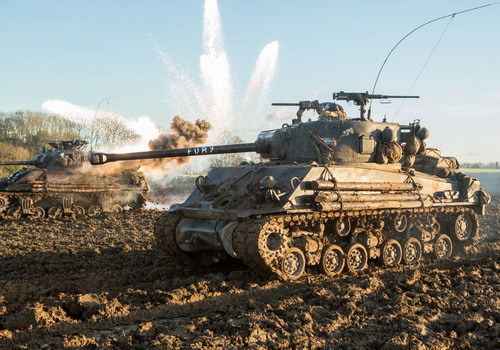
‘Fury’ uses 5 tanks for filming
This thrilling World War II film uses versions of the M4 Sherman tank to enhance its history and provide the highest visual effect.
In the work Fury, in addition to the acting element of the cast, many viewers were also impressed with the set design and especially the appearance of the tanks. There were 5 main vehicles used for filming and all were versions of the M4 Sherman tank. In the film, these 5 tanks are codenamed Fury, Matador, Lucy Sue, Old Phyllis and Murder Inc.
For Ian Clarke, the vehicle coordinator for the scenes, and Jim Dowdall, the tank crew supervisor, finding 5 World War II-era tanks began like any other task – finding partners.

Photo of the Fury tank.
Dowdall said: “We think it’s best to find trained tanks who have been in Afghanistan or other battlefields. Not only do they control the tanks correctly, but they also know what to do if something goes wrong with these vehicles over 70 years old.”
There were 3 different tanks used for scenes involving Fury. This included a Sherman tank with a 76 mm gun, courtesy of the Bovington Tank Museum.
With scenes shot inside the Fury, production designer Andrew Menzies created his own model. “That’s the biggest technical challenge, because it’s a very small model; The 4 sides can all be disassembled so that David can shoot from any angle,” Menzies said. Gary Jopling, assistant art director, said: “It’s no different than an internal compartment of a real tank. With the gimbal system, it can move, shake and rotate 360 degrees. The gun can protrude and fire.”
To render the scene inside the tank, the art department scanned its image and zoomed in 10% more than its actual size. From the scan, they built a background from metal box frames. Then they decorated this “box” like the space inside the tank. In addition, the filmmakers also found an innovative solution to show off the Fury that can load, fire and release shells through the help of special effects.

Brad Pitt visits the Bovington tank museum in Borset, England.
In the film, the American tank faces the most dangerous opponent, the German Tiger tank. “At the end of the day, it’s a war of tanks. A Sherman really has very little chance against a heavily armed Tiger,” Menzies said.
Only 6 Tigers from that era remain, and the Bovington Tank Museum has only one operable. “The Tiger 131 is a very important tank. This was a tank standing on a hillside in Tunisia and attacked by British tanks of the 48th Tank Brigade. It destroyed at least 2 Churchill tanks, but it was eventually defeated by others. The crew abandoned the tank and after the war, it was handed over to the museum,” museum director David Willey said.
The filmmakers did not want to damage this historic tank so created an alternative version for use in dangerous scenes, which could cause damage to the real tank.
Fury was filmed over 12 weeks in fields in Oxfordshire and Bovingdon Air Force Base in Hertfordshire. According to producer John Lesher, there were many reasons for the crew to come to England. “First of all, there’s a great base to start the production process. Secondly, in England there are many props such as tanks, armored vehicles, both German and American. Thirdly, the lighting and weather in England are perfect for German scenes. For these three reasons, Britain is an ideal place.”

A corner of the set of the movie “Fury” is located in England.
Before production began, director David Ayer and his team researched aspects of the story: from the type of tank, the weapons on the battlefield to the costumes. “Everything has to be taken care of in every detail. Sometimes the audience doesn’t understand what they’re watching. But only when everything is correct will the scenes be made vividly. That’s what I’m after,” David Ayer said.
Producer Ethan Smith said: “What David wants is not a cinematic reference to history, but an honest reflection of history. So we sat for hours looking at information corps materials, studying carefully how soldiers walked, carried weapons, approached a mission or relaxed on the side of the road. That’s the kind of thing for this movie.”
In addition, David Ayer and his team were helped by 3 military advisors and 4 Armored Division veterans who served in World War II. Military advisors Kevin Vance and David Rae collaborated with the actors, training them to play the role of tank operators. Ian Sandford, a former paratrooper in the British Army, is a military adviser to actors who play German soldiers.